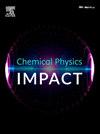基于qbd的绿色合成及生物功效增强的小叶莲叶提取物银纳米颗粒的多方面表征
IF 4.3
Q2 CHEMISTRY, PHYSICAL
引用次数: 0
摘要
目前的研究展示了一种新的、环保的合成银纳米颗粒(AgNPs)的方法,使用米特拉吉那细小叶提取物,在质量设计(QbD)方法的指导下,增强其抗炎功效。与传统的化学方法不同,这种绿色策略利用植物化学物质作为天然的还原和稳定剂。采用中心复合设计优化反应温度和孵育时间,实现可控的纳米颗粒合成,提高生物功效。利用光谱学和显微技术对合成的AgNPs进行了表征,证实形成了球形、结晶的纳米颗粒,zeta电位为-27.1 mV,具有很高的稳定性。紫外可见光谱在438 nm处发现了表面等离子体共振峰,而红外光谱分析显示存在官能团(-NH, -CH, -C = C),证实了小叶草植物成分成功封顶。XRD分析证实其为面心立方结构,平均晶粒尺寸为13.05 nm, TEM分析显示其为分散良好的球形颗粒,粒径范围为18 ~ 22 nm,具有SAED模式。体外对合成的AgNPs的抗炎潜力进行了评估,显示出显著的COX-2抑制作用(IC50 = 56.49µg/ml),蛋白质变性抑制作用(300µg/ml时为73.89%)和膜稳定性(100µg/ml时为85.94%),大大优于粗提物。这些增强归功于纳米尺度的尺寸和有效的植物化学相互作用。这项研究强调了qbd优化的、植物介导的AgNPs作为潜在抗炎药的前景,并强调了它们在可持续纳米医学发展中的重要性。本文章由计算机程序翻译,如有差异,请以英文原文为准。

QbD-based green synthesis and multifaceted characterization of silver nanoparticles from Mitragyna parvifolia leaves extract with enhanced bio-efficacy
The current study demonstrates a novel, eco-friendly synthesis of silver nanoparticles (AgNPs) using Mitragyna parvifolia leaf extract, guided by a Quality by Design (QbD) approach to enhance their anti-inflammatory efficacy. Distinct from conventional chemical methods, this green strategy leverages phytochemicals as natural reducing and stabilizing agents. A central composite design was employed to optimize reaction temperature and incubation time, enabling controlled nanoparticle synthesis with improved bio-efficacy. The synthesized AgNPs were characterized using spectroscopic and microscopic techniques, confirming the formation of spherical, crystalline nanoparticles with a zeta potential of –27.1 mV, indicative of high stability. UV–Vis spectroscopy revealed a surface plasmon resonance peak at 438 nm, while FTIR analysis indicated the presence of functional groups (–NH, –CH, –C = C), confirming successful capping by M. parvifolia phytoconstituents. XRD analysis confirmed a face-centered cubic structure with an average crystallite size of 13.05 nm, and TEM analysis revealed well-dispersed spherical particles ranging from 18 to 22 nm, with SAED patterns supporting their crystalline nature. The anti-inflammatory potential of the synthesized AgNPs was evaluated in vitro, showing significant COX-2 inhibition (IC50 = 56.49 µg/ml), protein denaturation inhibition (73.89 % at 300 µg/ml), and membrane stabilization (85.94 % at 100 µg/ml), substantially outperforming the crude extract. These enhancements are attributed to the nanoscale size and effective phytochemical interaction. This study underscores the promise of QbD-optimized, plant-mediated AgNPs as potential anti-inflammatory agents and highlights their relevance in the development of sustainable nanomedicine.
求助全文
通过发布文献求助,成功后即可免费获取论文全文。
去求助
来源期刊

Chemical Physics Impact
Materials Science-Materials Science (miscellaneous)
CiteScore
2.60
自引率
0.00%
发文量
65
审稿时长
46 days
 求助内容:
求助内容: 应助结果提醒方式:
应助结果提醒方式:


